September 19, 2008
Air Date: September 19, 2008
FULL SHOW
SEGMENTS
Green Car Bailout
/ Jeff YoungView the page for this story
Detroit's big car makers want $25 billion in taxpayer loans to help them retool to build cleaner cars. But will the money really go toward making cars go farther on a gallon of gas? Living on Earth's Jeff Young questions GM's top executive to find out. (06:00)
Petrol’s Price Pushers
View the page for this story
The price of oil has been on a wild ride this year, and some say physical supply and demand can't explain the dramatic ups and downs. Hedge fund manager Michael Masters talks with host Bruce Gellerman about the role commodities futures traders play in pricing petroleum. (06:00)
BPA Update
View the page for this story
Bisphenol A, a chemical used in the lining of canned goods and in plastic baby bottles and many water bottles, has come under fire recently as a growing body of scientific evidence shows that the compound may be harmful to humans. One new study shows that people with high levels of BPA are more than twice as likely to develop heart disease and diabetes. Dr. Nira Ben Jonathan of the University of Cincinnati College of Medicine just published a new study that looks at the effects of BPA on humans. As she tells host Bruce Gellerman, she found that when low levels of BPA are added to human fat tissue, it suppressed a hormone that regulates insulin. (03:00)
War of the Sciences
/ Ashley AhearnView the page for this story
Even as numerous studies link bisphenol A to health risks in humans, the Food and Drug Administration maintains that the chemical is safe. As Living on Earth’s Ashley Ahearn reports, this has led to intense controversy. (04:30)
Paying to Pollute
View the page for this story
The Regional Greenhouse Gas Initiative is set to launch the first cap and trade carbon dioxide auction in the United States. Host Bruce Gellerman talks with Jonathan Schrag, executive director of RGGI. (06:20)
Farewell, Phil
View the page for this story
Philip Clapp was a powerful force for action on environmental issues from drinking water quality and over-fishing to global warming and the protection of wilderness. He led the National Environmental Trust for 14 years. Kevin Knobloch, head of the Union for Concerned Scientists, offers this tribute. (03:30)
Bear Truth
View the page for this story
The U.S. grizzly bear population is alive and well. That's according to government biologist Kate Kendall who spearheaded a five year project collecting and analyzing bear hair DNA. Producer Clay Scott went to Glacier National Park with Kate Kendall to learn more about her groundbreaking work. (05:30)
Hand-Me-Down Tomatoes
/ Helen PalmerView the page for this story
From Brandywine to Purple Cherokee to Mortgage Lifter - a beautiful new book celebrates one of the most delicious tastes of summer, the heirloom tomato. Living on Earth’s Helen Palmer spends some time with Amy Goldman, author of “The Heirloom Tomato: From Garden to Table” on her farm in the Hudson Valley of New York. (10:40)
Show Credits and Funders
Show Transcript
Host: Bruce Gellerman
Guests: Nira Ben-Jonathan, Michael Masters, Jonathan Schrag
Reporters: Ashley Ahearn, Helen Palmer, Clay Scott, Jeff Young,
Kevin Knobloch
[THEME]
GELLERMAN: From Public Radio International, this is Living on Earth.
[THEME]
GELLERMAN: I’m Bruce Gellerman.
Brother can you spare a dime? How about 25 billion….dollars? That’s what GM wants to borrow from taxpayers to retool its factories.
BECKER: We need to get cleaner vehicles that pollute less, that guzzle less gas, and that will cut our addiction to oil, save us money at the gas pump and cut global warming pollution. And that’s the least we can expect from companies that we help bail out.
GELLERMAN: Just how green a bang will we get for all those greenbacks? And on the cusp of the Autumn equinox – we savor the last fruits of summer.
GOLDMAN: There’s the Radiator Charlie’s Mortgage lifter – there’s the Nebraska wedding tomato – you know – the heirloom tomato is the people’s tomato – It’s of, by and for the people.
GELLERMAN: Take your pick of these stories and more this week on Living on Earth. Stick around!
ANNOUNCER: Support for Living On Earth comes from the National Science Foundation and Stonyfield Farm.
[MUSIC: Boards Of Canada “Zoetrope” from “In A Beautiful Place Out In The Country” (Warp Records 2000)]
Green Car Bailout

The Chevy Volt.
GELLERMAN: From the Jennifer and Ted Stanley studios in Somerville, Massachusetts, this is Living on Earth. I’m Bruce Gellerman, in for Steve Curwood.
General Motors just celebrated its 100th birthday. But GM didn’t spend much time reflecting on history - it’s busy trying to figure out its future. The company, indeed all US auto makers, have been in a skid for decades, whiplashed by quality conscious consumers who are turning from the makers of gas guzzlers to manufacturers who make more efficient models. GM, Ford and Chrysler all say alternative-powered vehicles are just down the road. But to help them make the switch the companies want American taxpayers to pony up as much as 25 billion dollars in loans. But will all those greenbacks from Uncle Sam really get Detroit to make greener cars? Living on Earth’s Jeff Young reports from Capitol Hill.
YOUNG: To mark its first hundred years GM rolled out what it hopes will be the car to lift it from disastrous sales doldrums - the Chevy Volt.
[APPLAUSE, MUSIC]
YOUNG: The Volt is a four-passenger, plug-in electric car that could go 40 miles before any fuel is burned. It’s due in showrooms in about two years and is already generating some buzz. But GM says it needs some help to actually make the Volt and other high mileage cars. Hours after the Volt’s rollout, GM CEO Rick Wagoner was on capitol hill trying to persuade Congress to put up 25 billion dollars in loans.
WAGONER: Our industry has a real opportunity to move away from our traditional almost complete reliance on oil that powers our vehicles. And I think the 25 billion dollars included in the energy bill last year would be very helpful in enabling the industry to move more rapidly.
YOUNG: Wagoner wants Congress to come up with money it authorized but never made available last year when lawmakers approved tougher standards for fuel economy. To get industry’s agreement to make autos averaging 35 miles per gallon by the year 2020, Congress included government-guaranteed loans to help automakers retool factories. It could cost taxpayers five to seven billion dollars to back up the low interest loans. Senate Democratic leader Harry Reid says that seems like a bargain after the week’s big money bailouts on Wall Street.
REID: Five billion will give these companies the ability to retool to compete with the rest of the world. I think that’s small change and it would help.
YOUNG: But there is also skepticism and resentment among lawmakers who butted heads with car companies for years over fuel efficiency, like Florida Democratic Senator Bill Nelson.
NELSON: I believe that you really need financial incentives to retool. But I must admit it is hard for me to do that when each year I’ve been in the senate you all collectively Detroit – have opposed us and beat us every year when we tried to increase miles per gallon standards.
YOUNG: I caught up with Wagoner for a few questions. He was still bristling at criticism that Detroit had dug its own hole by fighting fuel efficiency.
WAGONER: To those critics I say for one thing we spent $103 billion in past 15 years on pensions and health care. If they look category by category GM has more vehicles that get 30 mpg than any other manufacturer in this country. We have more hybrid vehicles on the road than any other manufacturer. I think it¹s silly to say we should be punished for having done the best trucks, we’re glad we did the best trucks. And frankly all manufacturers have been hit by this radical change in the market condition, not just GM, not just Ford so I think people saying that really are not looking at the facts.
YOUNG: How do taxpayers know they’re going to get greener vehicles out of this deal?
WAGONER: Well, the legislation will call for that, and I would say not only that, they could walk into any GM showroom right now and see almost monthly a growing number of hybrid vehicles, significantly better fuel economy in each generation of products, and if they want to wait a few years they can see a Chevy volt, so they can see a lot of evidence.
YOUNG: But it’s not clear how many Volts GM plans to generate. Longtime clean car advocate Dan Becker, with the group Climate Safety Project, tracked GM’s public comments to the Department of Transportation, as the department sets the first rules to implement the new, higher fuel economy standards.

The Chevy Volt.
YOUNG: Becker says automakers should be made to go even further than the current target of 35, to 40 mpg - something the National Academy of Sciences says is within technological reach. Instead, it appears automakers are already trying to weaken requirements. For example, last year’s energy act said companies that want loans have to put that money toward making vehicles at least 25 percent more efficient. GM’s Wagoner asked lawmakers to remove that restriction. Becker says that’s the wrong way to go.
BECKER: We need to get cleaner vehicles that pollute less, that guzzle less gas and that will cut our addiction to oil, save us money and cut global warming pollution. And that’s what we can expect from companies we help bail out.
YOUNG: Back in the 1950s, when the big three automakers were really big, a GM executive told congress “What’s good for the nation is good for GM, and vice versa.” If the leading automakers really do use taxpayer money to cut the country’s oil dependence, then that might still ring true. For Living on Earth, I’m Jeff Young in Washington.
Related links:
- Read GM’s comments to the government on fuel economy and cars like the Volt
- GM’s Volt
- The Union of Concerned Scientists on oil-saving benefits of fuel economy standards
- GM’s Rick Wagoner and others at Senate energy summit
Petrol’s Price Pushers
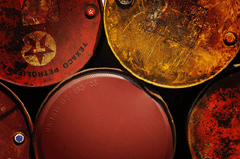
The price of oil reached a record high of $147 a barrel in July. (Photo: Mattias Barthel)
GELLERMAN: The price of petroleum has had America over a barrel. First it was soaring, then sinking, and now who knows where it’s heading, or why? Over the past year Congress has held more than three dozen hearings on the price of oil. At the latest, this past week, hedge fund manager Michael Masters told a Senate subcommittee that supply and demand can only explain a part of the volatility. Masters says the real reason is market manipulation, not necessarily by a small group of Dr. No evildoers, but by institutional investors, who funneled hundreds of billions of dollars into what are called commodity index funds.
MASTERS: Crude went up and crude went down. And just coincidentally, it tracked exactly the money going in and the money going out. To really understand supply and demand, you can’t just look at supply and demand in the physical market. You have to look at supply and demand of investors’ dollars as well.
GELLERMAN: So these companies – these institutional investors – were buying these index funds in commodities and part of that index was petroleum and it was pushing the price up and up and up and up.
MASTERS: That’s right. The most popular index, which is the Goldman Sachs S & P index, petroleum consist - and petroleum dry products – consist of roughly 70 percent of the index. So in effect, every time they put in a dollar into one of these indexes, three quarters of that dollar roughly went into petroleum products. And thus, you had an increase in the price. And there’s a big difference between the capital markets and the commodity futures markets. Commodities represent inventories.
GELLERMAN: So people can buy and sell everything from pork bellies to petroleum.
MASTERS: They can, but again, they’re just inventories. Now when you buy a bushel of corn, it doesn’t provide any interest. It is a much different animal than a stock or bond. When someone buys a stock or bond, they don’t expect to take it home and have it for breakfast. So, the price of a crude oil barrel is determined by the supply and demand in the physical markets and the supply and demand in the commodity futures markets of investor dollars. Collectively, they determine what the price is. Unfortunately, you know, when you have an influx of investors into these markets, you have significant distortions. And the issue that makes them dangerous, if you will, is this whole mentality of “buy and hold.” Commodities are meant to be traded. Just buying and holding what you look like in the commodity futures markets is a giant consumer.
GELLERMAN: In January 2000 the price for a barrel of oil was about $24.
MASTERS: That’s right.
GELLERMAN: In July of this year it was about $147, nearly $150.
MASTERS: Right.
GELLERMAN: Now it’s below $100.
MASTERS: We noticed a very significant amount of dollars flowing into index funds really starting around 2003. In fact, in 2003 the amount of index investment from large institutional investors in the commodity futures markets was roughly $13 billion. And by July of this year, that figure had grown to $317 billion. And we found that in excess of $60 billion of inflows had happened between January of this year and May of this year. And then, from July 15th of this year to just recently, September 2nd, $39 billion of outflows. And so, the price of crude and the price of petroleum products and indeed all commodities actually correlated very well to the inflows and outflows of these large institutional dollars.
GELLERMAN: But that’s correlation, that’s not causation.
MASTERS: Well people say that but it’s pretty strong evidence. I mean, we’re not saying that it’s the only reason, I mean, there are supply and demand factors in the marketplace. But how any economist could explain a more than $50 increase from low to high and then a $50 subsequent decrease from high to low in the space of six months just on supply and demand factors is beyond me.
GELLERMAN: I was looking back over the last twenty years or so and the world’s supply of oil was about equal to the demand. It hasn’t been out of balance. And yet, every time we heard the price was going up it was because something was happening in Nigeria or there was a tropical storm that might hit the Gulf.
MASTERS: You heard about those issues in the first half of this year, and then you know you’ve actual other issues since July. In other words, Russia invaded Georgia, you had two hurricanes, and yet the price went down anyway. In fact, this year inventories from data published by the EIA, the Energy Information Administration, have been stable all year. And the interesting thing about this whole issue is that these large investors, they had the intention of staying for a long period of time. And I think the only reason they did come out was because of Congressional scrutiny.

The price of oil reached a record high of $147 a barrel in July. (Photo: Mattias Barthel)
GELLERMAN: Don’t we have laws against market manipulation?
MASTERS: We do have laws against market manipulation. We used to have better laws against excessive speculation. Unfortunately those laws over the past seventeen years or so have been changed. Wall Street has lobbied to remove many of the restrictions that used to exist. The real issue with this particular, you know, bubble – this has very dramatic effects on citizenry around the world. I mean, it’s one thing if someone drives up the price of pets.com or an internet stock and then back down, you know that affects the shareholders of that company, but it’s a much different issue when you start driving up the price of crude oil. The amplification of prices causes by Wall Street investment is a social justice issue. And so, having position limits, which is something that worked for a long time in the commodity futures markets, and worked well, put in again, would work well to help the price more reflect what true supply and demand really is and not the whims of Wall Street investors.
GELLERMAN: Well, Mr. Masters, it was good talking to you.
MASTERS: Thank you very much.
GELLERMAN: Michael Masters is founder, and manages, the hedge fund Masters Capital Management.
[MUSIC: Mike Castro De Mari “Car Groove” from Sweet Sugar Lounge ( Supersonic Studio 2006)]
GELLERMAN: Just ahead, putting a price on carbon to save the planet. Keep listening to Living on Earth!
Related links:
- The Commodities Futures Trading Commission regulates commodities speculators and says they aren't behind price spikes in commodities. Read the CFTC's report here.
- Download Michael Masters’ report here ….
- …and an update here.
- To learn more about index speculation, check out Michael Masters’ blog
[MUSIC: Claus Ogerman/Danilo Perez: “Across The Crystal Sea” from Across The Crystal Sea (Emarcy Records 2008)]
BPA Update
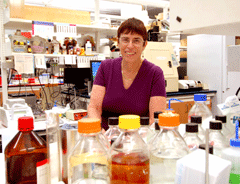
Dr. Nira Ben Jonathan of the University of Cincinnati.
GELLERMAN: It's Living on Earth, I'm Bruce Gellerman.
Bisphenol A is one of the most commonly used chemicals in the world. You’ll find BPA used in everything from plastic water bottles, and kids’ sippy cups to the lining of food cans.
You’ll also find it in more than 90 percent of people, and that may be cause for concern. Because new research - reported in the most recent issue of the Journal of the American Medical Association - suggests that people with high levels of BPA are three times as likely to develop heart disease and have a two-and-a-half times higher risk of diabetes than those with low levels.
These new findings were largely unexpected. Scientists are still trying to understand just how BPA acts once it’s inside the body. Dr. Nira Ben-Jonathan from the University of Cincinnati College of Medicine is one of those researchers. She says she was surprised to find that when she added BPA to human fat tissue, it suppressed a hormone in the body that regulates insulin called adiponectin.
BEN-JONATHAN: The low levels of bisphenol A, which mimic the environmental exposure that people are usually exposed to, reduce the secretion of a very important hormone adiponectin which is produced by fat tissue, and it’s protecting people from diabetes, cardiovascular diseases and arteriosclerosis. Almost in every patient, bisphenol A reduced the amount of adiponectin by anywhere from 20 percent to 50 or 60 percent.
GELLERMAN: So the amounts of bisphenol A that you added – would I have it in my body?
BEN-JONATHAN: Exactly. Many studies use very large amounts of bisphenol A, which is not something you would expect the find in people’s circulation or in the blood. But we selected doses of bisphenol A which exactly match the range of exposure that you find in over 90% of people.
GELLERMAN: Well, there’s another new study which was published in the Journal of the American Medical Association by a Dr. David Melcer. Are you familiar with that one?

Dr. Nira Ben Jonathan of the University of Cincinnati.
GELLERMAN: What would you like to see happen now regarding bisphenol A?
BEN-JONATHAN: I think we really need to take caution about this chemical because it’s very widespread, it’s one of the highest chemicals in commerce and I think that we’re exposed to it from multiple sources – from plastic bottles, from canned food, from medical tubings. And it’s fairly stable, but small, very tiny, amounts will be released and you get it into your system and it’s there.
GELLERMAN: Dr. Nira Ben-Jonathan is a professor at the University of Cincinnati College of Medicine. Her team’s research was published in the journal Environmental Health Perspectives. Well, Dr. Ben-Jonathan, thank you very much.
BEN-JONATHAN: My pleasure.
Related links:
- A new study from the Journal of the American Medical Association finds a correlation between high levels of Bisphenol A in human urine, and diabetes and cardiovascular disease.
- Dr. Nira Ben Jonathan's research on Bisphenol A in human fat tissue and lowered levels of the hormone Adiponectin.
War of the Sciences

Some manufacturers of polycarbonate water bottles made with bisphenol-A have begun phasing out the compound, which has been associated with cardiovascular disease and diabetes in humans. (Photo: Tom Clark)
GELLERMAN: The Food and Drug Administration doesn’t set limits on BPA, because the agency says there’s not enough scientific evidence that it’s harmful. But some scientists and consumer advocates strongly dispute that position and voiced their concerns at a recent FDA hearing. The intense controversy has ignited what’s being called “a war of the sciences.” Living on Earth’s Ashley Ahearn reports.
AHEARN: There’s a 93 percent chance that bisphenol A is in your body. Most of it gets there through what you eat and drink.
Dr. Laura Tarantino is one of the people who decide whether that’s a problem. She directs the office of Food Additive Safety at the Food and Drug Administration.
TARANTINO: From the totality of the evidence we have to come to kind of a yes/no decision and we believe thus far we don’t need to change the regulation at this time, that the levels to which people are exposed are safe.
AHEARN: At the recent hearing, several scientists and advocates questioned which studies FDA considered before it gave bisphenol A the “all clear.” Beth Jordan is medical director of the Association of Reproductive Health Professionals.
JORDAN: The FDA’s current draft assessment concludes that BPA is safe. This conclusion is based on two studies, both of which are funded by institutions that have a financial stake in the outcome of the FDA’s decision.
AHEARN: Tarantino says the FDA considered many non-industry studies before making its decision. But she said that even studies from respected peer reviewed journals weren’t adequate for FDA.
TARANTINO: Those are very useful, but they are not the same kinds of studies that were conducted specifically to look for feeding a compound in the diet, does it cause adverse effects? As far as I know no one has said give BPA to an animal for a lifetime and you see prostate cancer or breast cancer. None of those studies have happened.
AHEARN: That’s the FDA’s view. Now listen to Dr. Fred Vom Saal.
VOM SAAL: It causes breast cancer, prostate cancer, low sperm count in males. If you take every major human health trend, bisphenol A causes that in animals.
AHEARN: Vom Saal spoke at the FDA hearing. He’s a professor at the University of Missouri, Columbia and has published several studies on bisphenol A. He goes on:
VOM SAAL: It causes uterine fibroids and polycystic ovaries. It causes early puberty in females.
AHEARN: And on:
VOM SAAL: It causes brain damage that makes the brain of rats and monkeys look like the brain of a senile person.
AHEARN: And on…
VOM SAAL: and it also eliminates sex differences and leads to hyperactivity and learning disorders. It leads to obesity. So the array of harm that this chemical causes is absolutely stunning.
AHEARN: The way a chemical affects animals doesn’t necessarily predict the way it will affect humans. But bisphenol A acts like estrogen in the body and with a chemical that mimics a natural hormone, Vom Saal says even small doses can trigger big responses.

Some manufacturers of polycarbonate water bottles made with bisphenol-A have begun phasing out the compound, which has been associated with cardiovascular disease and diabetes in humans. (Photo: Tom Clark)
AHEARN: Though the FDA has so far opted not to regulate bisphenol A, at least ten states and Canada have moved to do so.
Some retailers and manufacturers, including Nalgene, the water bottle maker, are phasing out products containing the compound.
Consumer groups recommend avoiding canned food and number seven plastics.
For Living on Earth, I’m Ashley Ahearn.
Related links:
- The FDA on bisphenol A
- Dr. Fred Vom Saal wrote an editorial to accompany the recent JAMA study on Bisphenol A and Cardiovascular Disease and Diabetes.
[MUSIC: Mike Castro De Mari “Car Groove” from Sweet Sugar Lounge ( Supersonic Studio 2006)]
Paying to Pollute
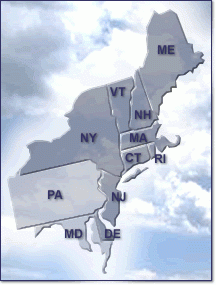
A map of the 10 states participating in RGGI. Pennsylvania, the fourth largest producer of coal in the country, is not a participant. (Courtesy of Deleware.gov)
[AUCTIONEER VOICE]
GELLERMAN: You can buy all sorts of stuff in an auction….
[AUCTIONEER VOICE]
GELLERMAN: from prize winning heifers…
[AUCTIONEER]
GELLERMAN: …and classic cars…
[AUCTIONEER]
GELLERMAN: …to fine art.
[AUCTIONEER: “…TWICE … SOLD, ONE MILLION FIFTY THOUSAND DOLLARS” ]
GELLERMAN: Well, soon there will be a new auction. The first of its kind in the United States, where they’ll put on the block something you can’t see, you can’t smell, and you can’t touch. But unless we put a price on it, it could poison the planet.
The new auction will determine how much carbon costs - specifically how much it will cost utilities in ten New England and mid-Atlantic states - to emit carbon dioxide into the atmosphere.
The states have banded together to form what’s called RGGI, the Regional Greenhouse Gas Initiative. RGGI has set a cap on the amount of CO2 the utilities can release, and is selling off the rights to pollute at auction. Jonathan Schrag, the Executive Director of RGGI, says the bids utilities placed online will be open September 25th.
SCHRAG: What’s special about it in the world is that it’s the first time there’s an auction. This program will, in fact, put a price on, and begin the process of utilities and all of us understanding the impact that carbon dioxide emissions have on our everyday lives.
GELLERMAN: I understand the goal of putting a price on carbon dioxide. But it does sound a bit strange to offer up a permit and have people pay to pollute.
SCHRAG: Well, you know, I think people thought that way when they were told they had to stop throwing their sewage out of the window too, and that they needed to start paying for the sanitation department trucks to come by and pick garbage up. Fundamentally, this is a question of awareness. It’s understanding that the country’s dependence on fossil fuels creates an externality of carbon dioxide emissions which needs to be managed and needs to be understood and recognized as the cost that it is. That’s not to say that fossil fuels don’t have a role in the overall energy economy. It’s that those resources need to compete with other energy resources on a fair playing field, one in which the carbon dioxide emissions have a cost.
GELLERMAN: So a utility buys an allowance, buys a ton or more of carbon dioxide, and then they’re supposed to use that money to reduce the amount of carbon dioxide they’re emitting? Is that right?
SCHARG: No. The money that’s going to be earned will go to the states. And the states will use the money through strategic investment into a number of initiatives related to energy efficiency, renewable energy, and other energy-related consumer benefit programs. So, the utility will buy an allowance and will hold that allowance. At the end of 2011, the end of the first three-year compliance period, they need to produce the number of allowances for all of the tons of carbon dioxide they have been emitting over that three-year period. If they don’t have enough, they get a big fine. If they have too many, they can sell them back into the market.
GELLERMAN: Now when this was set up a couple of years ago, you were expecting to have what – the limit 188 million tons of carbon dioxide, but, because of certain factors, right now we’re producing a lot less carbon dioxide.
SCHARG: We’re producing about ten percent less than we had anticipated, the region is. And that’s related to some short-term factors: the weather, the relative price of fuels, switching from higher carbon to lower carbon fuels, and those are short-term trends. We’re focused on building a long-term market, and so the contribution that RGGI is making is getting that infrastructure of a cap-and-trade system into place.
GELLERMAN: So utilities bid on these carbon dioxide emissions. The money goes to the states, and they’re supposed to do energy efficiency kind of things. Where does somebody like me fit into this picture? Do I wind up paying for this? I got a feeling, I do.
SCHARG: Yeah, you’ll pay about a dollar a month more in the near term. In the long term, you’re going to save. Because if you don’t have RGGI, you’re going to be asked to pay for new power plants to meet higher load. And what RGGI is doing, by making its strategic investments in energy efficiency, is reducing the need to build new power plants.
GELLERMAN: If I wanted to could I go online and place a bid for a ton of carbon dioxide?
SCHARG: If you’d gotten an application in by August 8th, you could have. You certainly can participate in the next auction, which will be December 17th. We welcome anyone. Organizations, individuals, financial, institutions, manufacturers, utilities. It’s wide open and not just to the United States, anyone internationally.
GELLERMAN: You know there are a lot of failing financial institutions on Wall Street and the financial centers around the world and they’ve got a lot of carbon dioxide credits in their portfolio. How does that affect the price that you hope you guys get for your carbon dioxide emissions?
SCHARG: Well, I suspect that just the same way that the weather or the relative price of fuels would affect the auction price, similarly the fact that our auction is occurring relatively close in time to a burp on Wall Street and a major disruption in the U.S. financial system, that might take some bidders out of the auction. We have enough participation from enough sectors that we expect a very robust and competitive auction. We think we’re stable enough to weather the storm.
GELLERMAN: I know that many other states and places around the world are closely watching this auction to see how it goes.
SCHARG: Well, you know, we’re trying hard to make it a success. I can say there wasn’t a lot of vacation this summer for the RGGI state staff. And I’m sure there’re gonna be things that on Monday morning we wish we would have done differently.

A map of the 10 states participating in RGGI. Pennsylvania, the fourth largest producer of coal in the country, is not a participant. (Courtesy of Deleware.gov)
GELLERMAN: Well Mr. Schrag, good luck with your auction.
SCHARG: Thanks so much. Thanks for having me.
GELLERMAN: Jonathan Schrag is the Executive Director of the Regional Greenhouse Gas Initiative Incorporated, or RGGI.
Related links:
- RGGI's webpage
- Living on Earth's previous coverage of RGGI
- Learn about Living on Earth's coverage of Californian efforts to cut greenhouse gas emissions here...
- ... and here.
[MUSIC: Dirty Dozen Brass Band “Save The Children” from What’s Goin On (Shout Factory 2006)]
Farewell, Phil

The late Philip Clapp. (Courtesy of National Environmental Trust)
GELLERMAN: Over the years, when we at Living on Earth needed information about a wide variety of environmental issues, we often turned to Philip Clapp. And Phil was always there for us - wise and funny and kind. Phil Clapp was Deputy Managing Director of the Pew Trust’s Environmental Program. His specialty was global warming, and this is what he told us back in 1997, after the first Kyoto climate change summit.
CLAPP: The most important piece is that we have to work with the developing countries to bring them in, in a way that recognizes their level of economic development, the aspirations of their people for an improved lifestyle. I felt one of the most apt statements at this conference was someone said that what we really had here was the nations of sport utility vehicles telling the nations who rode bicycles that they could never even have a scooter. And that, in essence, is a very, very serious limitation on their ability to improve their lifestyles. And what we have to do is put together a package that really recognizes their state of development.
GELLERMAN: The world will have to come to terms with climate change without the wisdom and wit of Philip Clapp. He died September 17th at the age of 54.
Kevin Knobloch, the Executive Director of the Union of Concerned Scientists was Phil Clapp’s friend and colleague.
KNOBLOCH: News of Phil’s death hit me like a stun gun. This is a guy who fearlessly leads the charge, whether everyone else is following or not. You want him by your side in a tough fight, analyzing the options, designing the plays, setting the pace.
Our work is now much harder without him.
I met Phil twenty-five years ago in the Rayburn House Office Building in Washington. He was serving as legislative director to an enormously talented Representative from Colorado, Tim Wirth, and I worked for another progressive Democrat down the hall.
Phil dressed more snappily than the average Congressional aide, and he talked about ways to fight off efforts to weaken air quality and advance drinking water protections with a puckish smile.
Working with Tim in the early 1980s, he was one of the few prescient voices calling the alarm that our planet was heating up. Many of the laws that help Americans live longer and breathe easier have Phil’s imprint on them.
Then there’s the harmful proposals that Phil helped stop before they became law. In the mid-90s, Newt Gingrich and his Contract With America threatened environmental and health protections. Phil founded the National Environmental Trust in response, and orchestrated the skillful campaign that outfoxed much better funded polluting interests. He helped Americans see that the benefits of those laws far outweighed the modest costs.

The late Philip Clapp. (Courtesy of National Environmental Trust)
At the international climate negotiations, from Kyoto in 97 to Bali last December, delegates and reporters from all over the world sought Phil out to decipher procedural mysteries and provide a razor sharp analogy.
He called the domestic auto companies America’s “can’t do” industry as they refused to build the fuel-efficient cars and trucks that they had the technology and talent to do.
You knew it when Phil showed up. His lean frame and outsized gestures made him seem a foot taller than he was. The antidote to a stuffy room full of self-important people was to sit next to Phil just to hear his hilarious and piercing commentary.
Phil died in a city he loved, Amsterdam, and that seems like a blessing among the deep sadness. God bless you, Phil.
GELLERMAN: Kevin Knobloch is Executive Director of the Union of Concerned Scientists.
[MUSIC: Abdullah Ibrahim “The Mountain Of The Night” from African River (Enja 1989)]
GELLERMAN: Just ahead, the science and politics of grizzly bear DNA. Stay tuned to Living on Earth.
Related links:
- To hear or read Living on Earth interviews with Phil Clapp, click here
- here...
- ....and here
Bear Truth
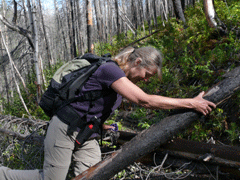
U.S. Geological Survey biologist Kate Kendall led the Northern Divide Grizzly Bear Project. (Photo: Clay Scott)
ANNOUNCER: Support for the environmental health desk at Living On Earth comes from the Cedar Tree Foundation. Support also comes from the Richard and Rhoda Goldman Fund for coverage of population and the environment, and from Gilman Ordway for coverage of conservation and environmental change. This is Living On Earth on PRI, Public Radio International.
[MUSIC: Rachel Z: Love Will Tear Us Apart from Dept Of Good And Evil (Savoy Jazz 2007)]
GELLERMAN: It’s Living on Earth, I’m Bruce Gellerman.
In his campaign ads and on the stump, Republican presidential hopeful John McCain talks tough about squandering government money on pork barrel projects.
McCAIN: We’re never going to spend three million dollars again to study the DNA of bears in Montana. I don’t know if it was a paternity issue or a criminal issue but it’s not going to happen again.
GELLERMAN: Actually, McCain is wrong. The federal government spent 4.8 million dollars studying grizzly bear DNA. The money went to fund Kate Kendall’s research in Northwest Montana. Kendall is a biologist with the U.S. Geological Survey. She studies grizzlies in Glacier National Park, one of the bear’s last strongholds in the U.S.
Since 1975, grizzlies have been protected by the Federal Endangered Species Act. Producer Clay Scott recently spent a day with the scientist in the field, and has our report.
[AMBIENT SOUND WITH BIRDS, RIVER]
SCOTT: Most people try to avoid grizzly bears. Kate Kendall has spent her career looking for them. On an early September day, Kendall and two researchers are in Glacier National Park on an ongoing study of grizzly bear behavior.
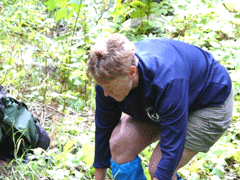
Volunteer Karla Yates mimics the movements of a bear so the research team can mount the camera to record bears in action. (Photo: Clay Scott)
RESEARCHERS: Yeah, be a bear. Be a bear! OK….
SCOTT: The team is setting up remote video cameras, hoping to get footage of grizzlies. This is steep terrain, a jungle of spindly lodge pole pine. It’s one of the places where Kendall and her researchers carried out their recently completed, five-year-long grizzly DNA study.
KENDALL: Eight-million acre study area is the size of Maryland and Delaware combined. It’s 80% the size of Switzerland, and this is extremely rugged and remote area to do work in. It’s logistically very challenging to do work in, and we were actually able to do the fieldwork for 25 cents an acre.
[WALKING]
SCOTT: Kendall carries a pack loaded with heavy equipment, but steps nimbly over fallen logs. Huckleberries are still ripe here, and so close to the trail that we can pick them without breaking stride. But good berry country is also good bear country. The team doesn’t want to surprise one while they’re setting up equipment.
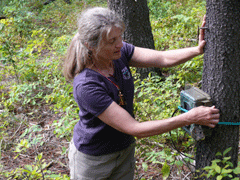
This motion sensor detects when a bear is approaching and turns on the camera. (Photo: Clay Scott)
SCOTT: Bear sign is everywhere: scat, filled with huckleberries. Tracks in the dust. Suddenly, Kendall stops and approaches a lodge pole pine. To my eyes, it looks the same as any other.
KENDALL: So, you can see the claw marks here - it’s from bears reaching up, rubbing themselves, grabbing over their head on the trees.
SCOTT: And why do they do that?
KENDALL: Chemical marking, that’s what we think. Chemical communication. For other bears. Let ‘em know they’re in the neighborhood.
SCOTT: To demonstrate what grizzlies do at the trees, Kendall unselfconsciously imitates one, rubbing her back against the lodge pole, scratching the trunk.
KENDALL: You know, what we look for in a rub tree is when you’re hiking along a regular trail, is you often find a little trail going to the base of a tree, and kind of a bare spot below it and then most of all you look for kind of smooth bark, and then you look for bear hair, which…here’s a wad of it right here.
SCOTT: Kendall points to a clump of hair wedged in the bark. Black bears use rub trees as well, but this hair, she says - light brown with a silver tip - is almost certainly from a grizzly. And she should know. During the study she directed of grizzly bears in the Northern Continental Divide Ecosystem, Kendall and more than 200 researchers took hair from nearly 5,000 rub trees. They also set up 2,500 barbed wire hair traps, baited with a foul-smelling concoction of rotten fish and cattle blood. In all, they collected 34,000 grizzly bear hair samples.
KENDALL: The more weathered it is, the more the DNA is broken down, degraded, and it’s harder to get good genetic results from that. There’s also very little DNA in one single hair. So the more degraded and the smaller the sample, the more difficult it is.

U.S. Geological Survey biologist Kate Kendall. (Photo: Clay Scott)
KENDALL: To put that into perspective, this population is one of only two viable populations left south of Canada, of grizzly bears. It was listed as threatened in 1975, and we have never had any baseline data for the entire ecosystem.
SCOTT: Kendall’s research found that the bears’ range was much larger that had been believed, and that the genetic health of the population was good. Those results have been applauded by some who believe the grizzly’s endangered status was an impediment to drilling and development in Northwest Montana. The U.S. Fish and Wildlife Service is reviewing the bear’s status in Montana. But Kendall says her goal was simply to get a reliable snapshot of the population, to provide good scientific data where none existed.
[WALKING]
SCOTT: The Northern Divide Grizzly Bear Project is over, but Kendall’s research continues. She says she still has much to learn about grizzly bears.
KENDALL: They’re intelligent animals, so they have a lot of interesting behavior, and a lot of human-like qualities. I love the environments where grizzly bears live, wild places. I’ve been lucky enough to work in two of the most beautiful national parks in the United States - Glacier and Yellowstone, because grizzly bears are there.
SCOTT: Kendall has logged hundreds of miles on backcountry trails, packed foul smelling bear lure, set up cameras, looked for rub trees. She has been close to many bears, and been charged by one. But the years of hard work, the occasional unpleasantness, and the occasional danger, she believes, have been worth it. Because grizzlies, she says, are part of who we are as humans.
For Living On Earth, I’m Clay Scott in West Glacier, Montana.
GELLERMAN: For incredible videos of the grizzlies - go to our web site, loe.org
Related links:
- Northern Divide Grizzly Bear Project
- See videos of grizzlies and other wildlife recorded by the USGS remote cameras
Hand-Me-Down Tomatoes
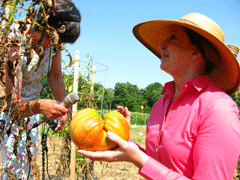
Author Amy Goldman, reporter Helen Palmer and a Sterling Old Norway heirloom tomato. (Photo: Joanna Rifkin)
GELLERMAN: The French call it “pomme d’amour” - love apple. And the English? Well, the English call it:
PALMER: Tom-ah-to.
GELLERMAN: That’s Living on Earth’s Helen Palmer, and as you can hear. she says -
PALMER: Tom-ah-to.
GELLERMAN: And we say: tomato. Well, we’re not going to call the whole thing off, because it’s that time of year again, when the last of the summer’s vine ripe love apples, are the apple of every foody’s eye. Recently a gloriously illustrated book about tomatoes caught our eyes here at Living on Earth. It’s Amy Goldman’s new tome: “The Heirloom Tomato.”
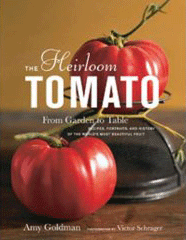
[SOUND OF CRICKETS]
GOLDMAN: Tomatoes and I go way back - I started growing them when I was seventeen years old - and ever since then I’ve had my hands in the soil.
PALMER: Amy Goldman grows peaches and blueberries, melons and squash. She keeps ducks and chickens, and, of course - she grows tomatoes. Today she wears a long sleeved shirt and broad brimmed straw hat against the brilliant late summer sun as she shows off her crops.
[SOUND OF WALKING ON STRAW]
GOLDMAN: We’re in the middle of Amy’s folly. This is an acre filled with 500 tomato plants, 250 different sorts, two of each.
PALMER: And unlike the tomato plants most of us buy from the supermarket - those four-packs of reliable hybrid varieties like Early Girl or Big Boy or Sweet 100 - Goldman grows heirloom tomatoes.
GOLDMAN: The term Heirloom - it means a tomato of value, capable of reproducing itself true to type, from seed that can be handed down to next generation.
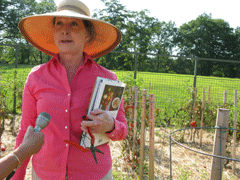
Author Amy Goldman in her tomato garden. (Photo: Joanna Rifkin)
GOLDMAN: The biggest mistake gardeners make is crowding them. I plant my tomatoes five feet apart in the rows and seven feet between rows. They need – first of all they need full sun. They need air circulation and that reduces the incidence of disease, and allows the plants enough room to grow and prosper.
PALMER: Still, even with optimal conditions and lots of space, some of Goldman’s tomato plants have shriveled brown leaves - just like mine.
GOLDMAN: This summer we’ve had a superabundance of water, and so the plants don’t like to have wet feet, and as a consequence, blight is on the march. We’re all in the same boat here and there’s not too much to be done. However, it’s interesting to see that some of these plants thriving and producing fruit by the bucket, so, we know that those are resistant to excess moisture.

Amy Goldman, reporter Helen Palmer and a Sterling Old Norway heirloom tomato. (Photo: Joanna Rifkin)
PALMER: Goldman heads down the row to a tomato plant with tentacle-like branches sprawling out over the straw.
GOLDMAN: In this most horrible of tomato years this plant is going gangbusters, I mean it’s moving across the garden at an alarming rate and in fact probably spreading out about eight to ten feet in diameter.
PALMER: This tomato’s leaves are bright green, and it’s laden with sprays of tiny currant-like fruits.
GOLDMAN: Alberto Shatters. It’s a very primitive plant. It shatters, it drops its fruit when the fruit is ripe. The tomato quality is superb, in fact it’s high in acid, high in sugar, very crunchy, and just wonderful. It’s probably, if not the smallest - one of the smallest tomatoes in the world, weighing in at about a gram. You know, you can’t even weigh it in ounces. It’s about a gram and the size of a garden pea.
PALMER: They taste good and you think they’re…?
GOLDMAN: Well, try it for yourself.
PALMER: I guess I’ll have to. Let’s see if I can find a ripe one.
GOLDMAN: Just give it a shake and they’ll fall off.
PALMER: These pea-sized tomatoes pack a powerful flavor punch - but that’s not their only value for Goldman.
GOLDMAN: Not only are they flavorful and historic and beautiful garden plants, but it’s been found that plants’ wild relatives contain genes that, bred into modern tomatoes can confer disease resistance and other fine traits.
PALMER: That’s one of the important lessons Goldman wants her heirloom tomato book to teach. She says the earliest wild tomatoes from South America’s coastal highlands were small ones like these Alberto Shatters - the plant was domesticated in Mexico and gradually bred and selected to create all the varieties we know today. Goldman points to a huge plant in the next row, bending with the weight of bunches of egg-shaped tomatoes.

King Humbert. (Photo: Joanna Rifkin)
PALMER: Let’s go look at it.
[WALKING]
GOLDMAN: There’s Re Umberto genes in every one of the plum tomatoes we know today. This was named in honor of Umberto I, King of Italy about 1878.
PALMER: One thing I’m noticing about it as I look at it is, it seems to be suffering less from the blight and the browning leaves than the others, and it’s very very heavily cropping. There are lots and lots and lots of tomatoes on it.
GOLDMAN: This is the value of this variety, because it’s low input, generations of Italian peasant farmers have grown it because it doesn’t require staking, it doesn’t require watering or any attention whatsoever.
PALMER: Those generations of Italians – like peasant farmers across the globe – recognized the value of this crop, so saved some of the seeds to plant the next year. They passed them on to their children – and their grandchildren – that’s the paradigm Goldman wants the rest of us to follow. Under many of her plants lie abandoned tomatoes, apparently rotting.
GOLDMAN: I couldn’t possibly eat all of the varieties that I grow and I joke I’m running a private CSA for my friends and family.
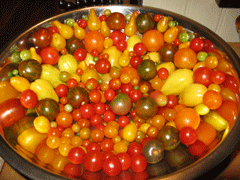
Tomatoes from Amy Goldman’s garden. (Photo: Joanna Rifkin)
PALMER: Goldman’s a board member of The Seed Savers Exchange, an Iowa based non-profit that’s gathered over 25,000 varieties of heirloom vegetables in the last thirty-three years.
GOLDMAN: The mission is to stop the extinction of our food crops. We have developed a network of people dedicated to collecting, conserving and sharing heirloom seeds and plants - while educating the general public about the virtues of genetic and cultural diversity.
PALMER: Goldman wants to spread this knowledge. She says one to two percent of heirloom varieties disappear every year as hybrids take over, and we might need that genetic diversity for our food crops in the future. Her book also traces the history of some 200 luscious tomatoes. It includes taste tests and recipes, and celebrates their evocative names.
GOLDMAN: There’s the Radiator Charlie’s Mortgage Lifter, there’s the Nebraska wedding tomato – you know, the heirloom tomato is the people’s tomato. It’s of, by and for the people. You know there’s a tomato called “My Owna” – because it’s my own.
PALMER: And there’s Black Prince, White Beauty, Silvery Fir Tree, Green Doctors, Plum Lemon, Purple Calabash, Sun and Snow. All shapes for all uses - cup-shaped ones perfect for stuffing, tiny cherries to pop like candy, mammoth meaty beefsteaks for sandwiches – and all sizes and all colors.
GOLDMAN: This tomato over here – is the yellow peach tomato.
PALMER: It’s not shiny.
GOLDMAN: It’s not at all shiny – in fact it’s fuzzy like a peach. The yellow peach tomato. This is strictly garden to table – this is a rare treat that can only be grown by the home gardener.
They’re so fragile, but so wonderful. And, I make a wonderful galette with the peach tomato and white peaches.
PALMER: So that’s a kind of pie?
GOLDMAN: It’s a kind of pie.
PALMER: Which goes to remind us that the chief joy of tomahtoes – or tomaytoes – however you pronounce them - is to eat them. And though we nibbled our way up and down the rows, it’s lunch-time.
[STARTING UP THE MULE]
PALMER: Goldman starts up the little garden cart she uses round the farm, to take us from the tomato field back to the farmhouse.
[BRAKING SOUNDS, BIRDS, CRICKETS]
PALMER: The smell of garlic and basil wafts out through the open kitchen door. Inside a dozen bronze casts of huge, perfect tomatoes and squash line the kitchen counter. A restaurant-size fridge and freezer hum and on the table are baskets of multicolored tomatoes.
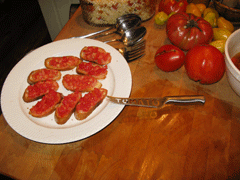
Spanish tomato bread. (Photo: Joanna Rifkin)
There’s nothing in the world like a homegrown tomato. And heirlooms – my 35 yrs of experience as a grower, plus considerable book learning - have taught me that heirloom tomatoes ripened on the vine in full sun are the most delicious tomatoes of all.
PALMER: And the tomatoes Goldman offered, and we ate, were indeed delicious. As another tomato season declines – as the nights get colder and the vines shrivel – I’m sad. But Goldman sent me home with a huge basket of assorted heirlooms – and I saved lots of the seeds for next year.
For Living on Earth, I’m Helen Palmer.
GELLERMAN: For loads of information about Amy Goldman’s book “The Heirloom Tomato” - and photos - and recipes! – go to our website loe.org.
[MUSIC: Heirloom Tomatoes: John Denver “Homegrown Tomatoes” from Higher Ground (Windsatr Records 2005)]
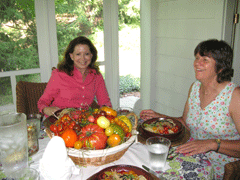
Amy Goldman serves Helen Palmer Spaghetti with Cherry Tomatoes and Toasted Crumbs
|
Yield: 10 portions The cherry tomato salad is the heart of this matter; a one-hour waiting period after assembly allows the salt, and the acid from the vinegar, to pull out the natural juices and flavor of the tomatoes. Toasted crumbs make a fine topping. I could eat this every day. Toasted Crumbs 1 loaf rustic bread Cherry Tomato Salad 1 pint sherry shallot vinaigrette (see recipe) 1. Preheat the oven to 350 degrees. 2. Remove crust from the loaf of bread. Cut bread into large dice. 3. Pulse in the food processor until pieces are medium sized. 4. In a large bowl, toss bread crumbs with olive oil, salt, and pepper. 5. Spread crumbs evenly on cookie sheets and bake, turning frequently until browned. Cool and reserve. 6. Slice the cherry and currant tomatoes in half. Combine with the sherry shallot vinaigrette one hour prior to serving. 7. Bring the water to a boil and add the salt. Cook the pasta until al dente, approximately 7 minutes. Drain. 8. Chiffonade the basils. 9. In a bowl, toss the pasta with the cherry tomato salad. 10. Plate the pasta, garnish with parmesan, basil, and toasted crumbs. Serve right away so crumbs remain crispy.
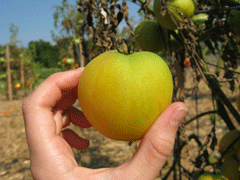 The yellow peach tomato before being baked into a galette. (Photo: Joanna Rifkin)
|





